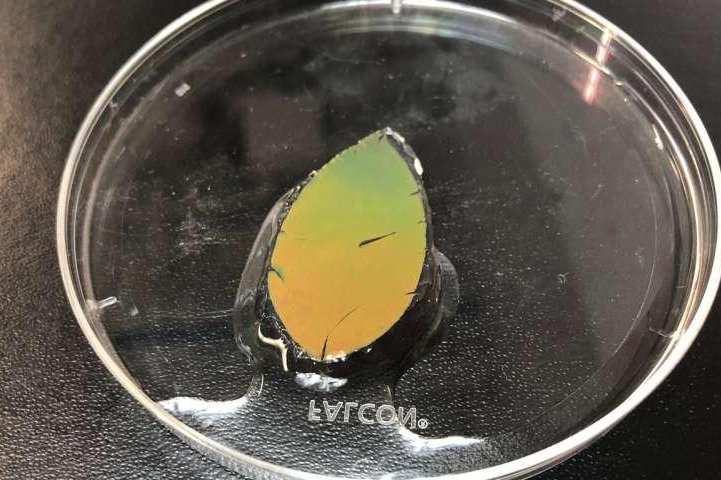The leaf-shaped smart skin changed colors in response to heat and sunlight, but it didn't change its size or shape. Photo by Emory University
Sept. 11 (UPI) -- Scientists have managed to create new "smart skin" that changes color but doesn't change size, just like a chameleon.
Researchers have previously created color-changing smart skin, but scientists have struggled to develop smart materials that stay the same size. The new smart skin reacts to heat and light, changing color, without altering its volume.
"Watching a chameleon change colors gave me the idea for the breakthrough," study author Yixiao Dong, a doctoral candidate in chemistry at Emory University, said in a news release. "We've developed a new concept for a color-changing smart skin, based on observations of how nature does it."
Photonic crystals in a chameleon's skin help the lizard change its appearance to better blend in with its surroundings. For some time, scientists have been trying to create similar photonic crystals.
"Scientists in the field of photonic crystals have been working for a long time to try to create color-changing smart skins for a range of potential applications, such as camouflage, chemical sensing and anti-counterfeiting tags," said Khalid Salaita, senior study author and a professor of chemistry at Emory. "While our work is still in the fundamental stages, we've established the principles for a new approach to explore and build upon."
Some fish species use similar crystals to change their appearance. The crystals are not pigment filled, but they are patterned in a way that allows some wavelengths of light to pass through and become absorbed, while causing others to be reflected. Changes in the spacing of the crystals or in lighting conditions can alter which wavelengths are absorbed and which are reflected.
Traditionally, scientists have embedded various photonic crystal arrays into flexible, water-containing polymers, or hydrogels, to create smart skin. When the polymer expands or contracts, the pattern of crystals changes, altering the material's appearance. But constant expansion and contraction can lead to structural instabilities.
"I wanted to understand why a chameleon doesn't get bigger or smaller as it changes color, but remains its original size," Dong said.
While watching videos of chameleons changing colors, Dong noticed that only parts of the lizard's skin are covered by patterns of photonic crystals. The patterns are interspersed with patches of dark skin. Dong realized the dark matrix adjust to compensate for changes in the patterns of crystals, helping the chameleon's skin maintain its size.
"I wondered if we could design something similar -- a composite structure of photonic crystal arrays embedded into a strain-accommodating matrix," Dong said.
In the lab, researchers used magnets to arrange iron oxide-based photonic crystals in a layer of hydrogel. Next, scientists embedded the arrays into a second non-color-changing hydrogel. Scientists designed the second hydrogel to accommodate the movement of the crystal arrays.
In lab tests, the skin successfully changed color in response to heat without altering its size. The smart skin, which scientists cut into the shapes of fish and leaves and took outside, also changed from orange-to-green in reaction to sunlight -- and without changing size.
The research team described their breakthrough this week in the journal ACS Nano.
"We've provided a general framework to guide the future design of artificial smart skins," Dong said. "There is still a long way to go for real-life applications, but it's exciting to push the field another step further."















